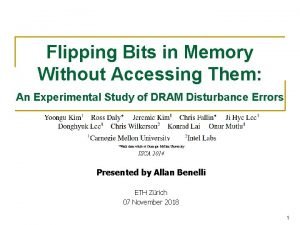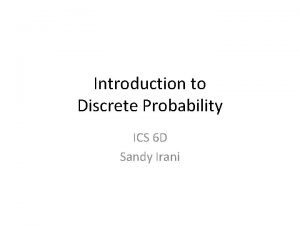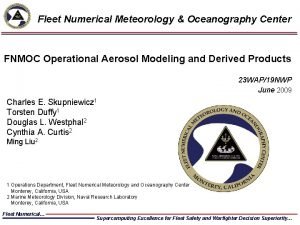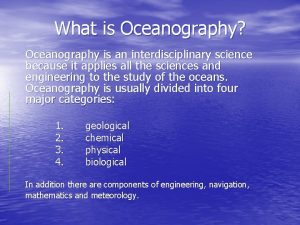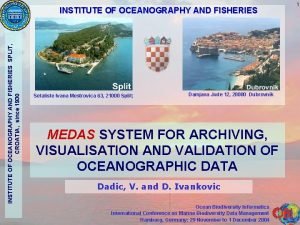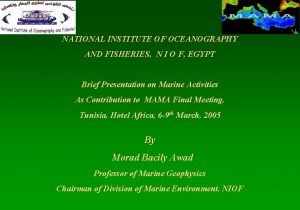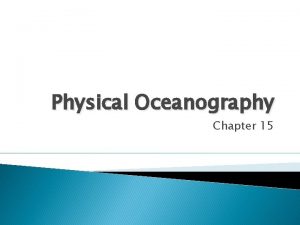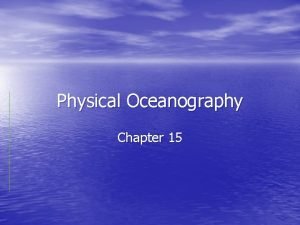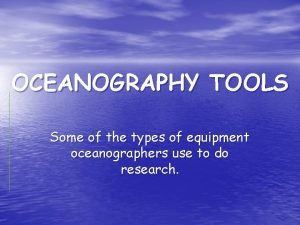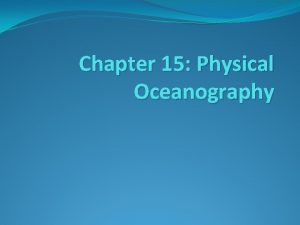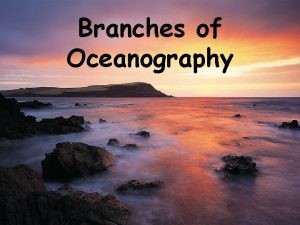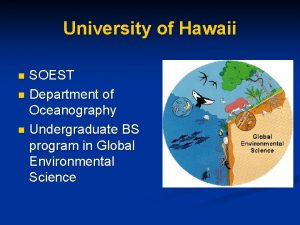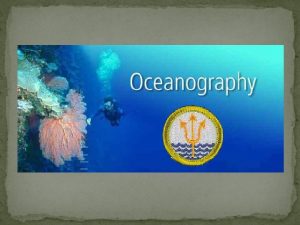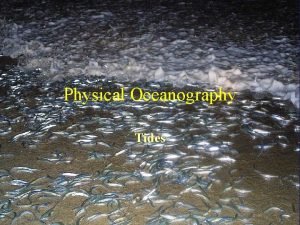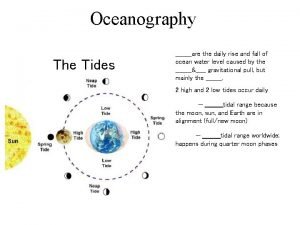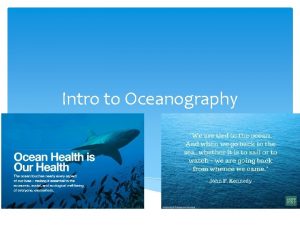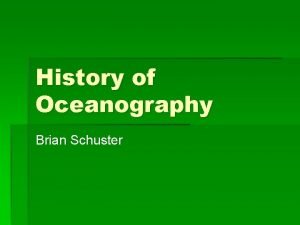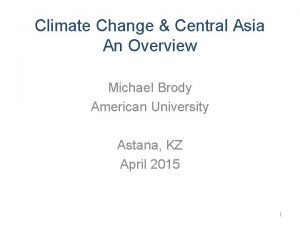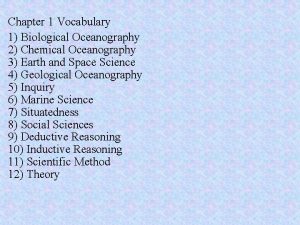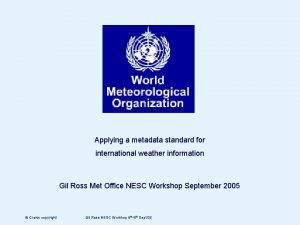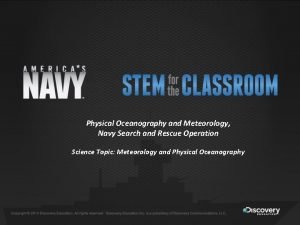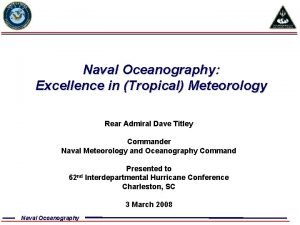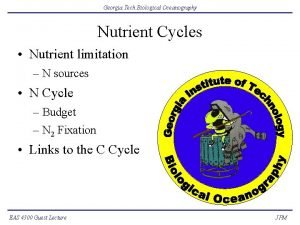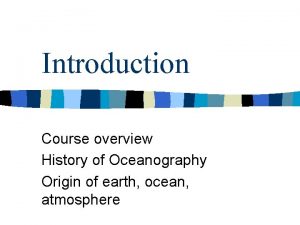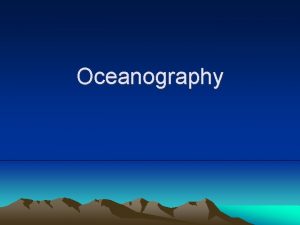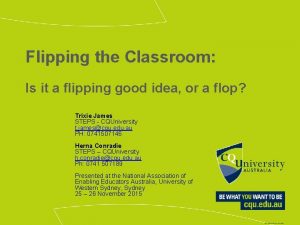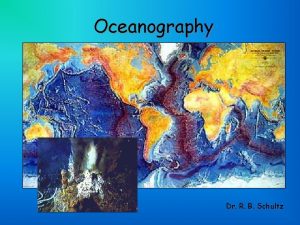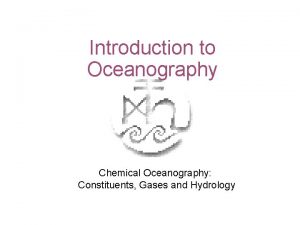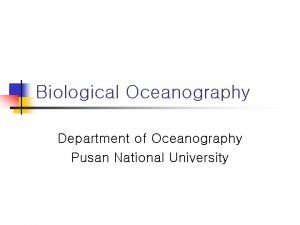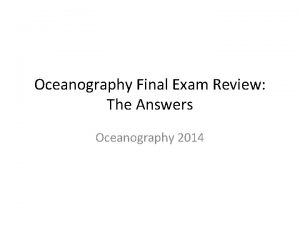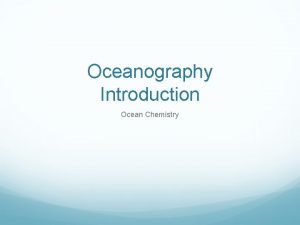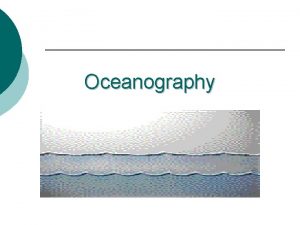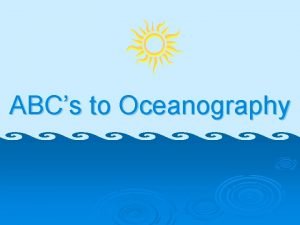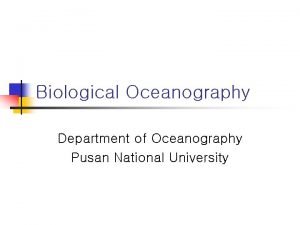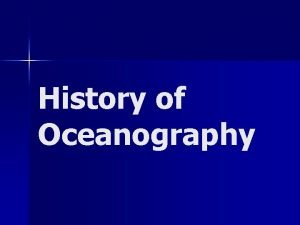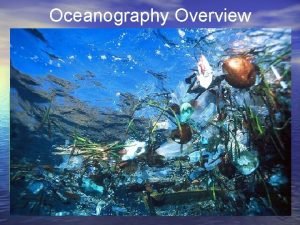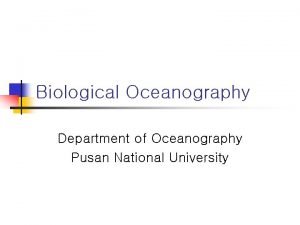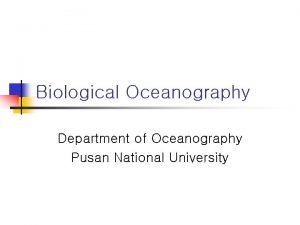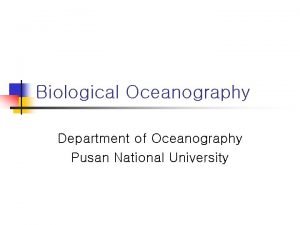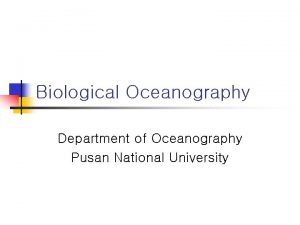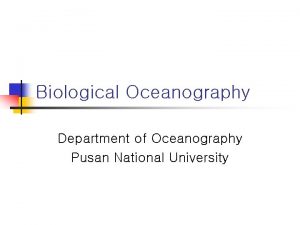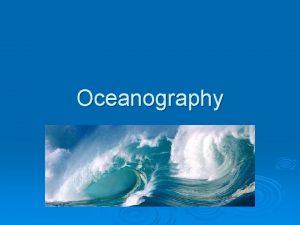Flipping the Classroom Oceanography Online and in an



























- Slides: 27

Flipping the Classroom: Oceanography Online and in an Active Classroom JANE E. DMOCHOWSKI, PH. D. JANEED@SAS. UPENN. EDU

�The process, the lessons learned A flipped course in Oceanography in Liberal and Professional Studies at the University of Pennsylvania. online office hours online quizzes online lectures active class time communication �Discussion Best practices for "flipping" the classroom, especially for university-level science courses. Expanding to more students? Going 100% online Flipping the Classroom: Oceanography Online and in an Active Classroom

Why Blended? Bloom’s Taxonomy of Learning Domains The Blended Model for Geol 130 • Understanding • Remembering • Analyzing, and Remembering • Understanding From UCDenver’s Assessment and Instructional Alignment website Applying, Online Modules Online Quizzes Online Chats/collaborations In-class: Assignments & Activities; Exams • Creating, Evaluating, Analyzing, Applying, Understanding

Flipped/Blended Learning (abbreviated) History 1990’s to today � Eric Mazur at Harvard, Peer Instruction, 1990 s. � Maureen Lage, Glenn Platt and Michael Treglia at Miami Univ: "Inverting the Classroom: A Gateway to Creating an Inclusive Learning Environment" in 2000 � North Carolina State “Active Learning”, RPI “Studio Physics” and MIT “TEAL” � Early 2000’s, multiple universities (and high schools) begin using online video to replace traditional lectures. University of Wisconsin at Madison (computer science) � Khan Academy, 2004, Salman Khan � Mid-2000’s on, Numerous publications (see Resources) about experiments with various models �. . . � Beginnings in 2008… 2011 -2012 Using MOOC’s + in-class instruction/activities via Ed. X, Coursera, Udacity

Connection to Science Literacy �How can blended learning help to increase science literacy? Active learning, specifically inquiry-based learning, has been identified as an effective way to disseminate knowledge in introductory science classes because of its interactivity and contextual basis. Active-learning and the blended/flipped classroom. Getting to higher-order learning objectives -> higher science literacy. Possibly faster/easier to move toward higher order objectives when teaching a blended class.

�Online lectures What did I do? �Online learning modules Taught this course each fall since 2006. �Focused my class time (3 2006 -2011 Implemented strategies to make the class time incorporate more active learning (concept questions, etc. ), but finding time to cover all necessary material in addition to doing activities was a limiting factor to creating a fully active classroom. Fall of 2012: Flipped course! hours every other week) with engaging students in the learning process �Utilize myself as a teacher and guide, rather than solely as a lecturer. “Guide on the Side” �Using a portfolio of teaching styles to address an array of learning styles.

�Course Management System: Tools Canvas �Recording Software: Camtasia �Chats: Skype, Adobe Connect �Outside videos and tools: NOAA Learning Objects Videos: http: //www. montereyinstitute. org/noa a/ Ted. Ed You. Tube Math: � Math. TV � Khan Academy � Prentice Hall Videos

Nuts and Bolts of the Course: Traditional classroom 14 LPS students On-line: Total 15% of grade § § Office Hours Modules (online lectures, quizzes and other content) 15% § Pre-lecture Quiz § Content Links § Video Lecture (me), 10 -55 minutes § Post-Lecture Quizzes In-Class/person: Total 85% of grade § Office Hours § Written Assignments (6) 12% § 2 Exams (70%) § Field Trip: 3% Grading them on the higher order, not lower order stuff, but making sure they understand the lower order is key to ability in the higher order. Tell them why!


Ex: Tidal Power Collect data from 4 plants on NOAA website… Figure out tidal pattern and range based on data… E = 0. 5 Aρgh 2 Calculate the energy potential from tides at each of the sites in the table above. Based on all of your calculations, which site is best suited for a tidal power plant. Why? --------------Tidal patterns, ocean energy, problem solving… Class time • Questions on module • Team collaborations on written assignments • • • Work together 5 -25 minutes, followed by 5 -20 minute group discussion Not a special classroom, but I did physically move chairs into groups of 24 Changed groups as I saw fit throughout semester to mix students

Ex of “Guide-on-the-side”: Slide of an image from the module without any text and ask students to describe and break down the slide. An atmospheric pressure map of the world. � “Okay, where are the high and low pressure zones located? ” There are high pressure zones over the northern hemisphere’s continents and the southern hemisphere’s oceans. � “What does this tell you? ” Well, we know water has a higher heat capacity than rock so in the winter the continents will lose the heat faster than the oceans, and in the summer the continents will heat up faster. So, the high pressure zones over the northern hemisphere’s continents shows it is cold there, since warm air rises, creating low pressure and cold air sinks, creating high pressure. � “Okay, so is it summer or winter in the Northern Hemisphere for this graph? � Winter! I then encourage them to study this way at home.

�The idea isn’t to allow the Important "Computers will not replace teachers, but they will certainly provide them with an important dynamic tool for improving the quality of education. “Eric Mazur technology to replace the teaching, but to help the teaching. �Let your students in on this. State and share clear objectives. Tell students WHAT you want them to learn and let them know HOW to best to study in your course so they can learn. I tell the students the assignments and modules are to help you learn, they are not meant as exams. Use them to learn.

Compared to 2006 -2011, how did the 2012 students do and how did they like it? Average of Midterm and Final Exam for LPS students only Comparison of Exam Scores for LPS students in GEOL 130 -601 Course Evaluations 100 4 90 3, 5 80 3 70 2, 5 60 50 2 Overall Quality of the instructor. 40 1, 5 Overall Quality of the course. 30 1 20 0, 5 10 0 2005 2006 2007 2008 2009 2010 2011 2012 2013 Year 0 2005 2006 2007 2008 2009 2010 2011 2012 2013 At least as well as LPS students in my “traditional” classes.

Do students really use the online lectures? How they use the modules 5 respondents

Analysis of Class and Decisions Before converting a traditional course, consider… � What do you want to change? More in-class discussion/activity time? Objectives of the assignments? Time to review lectures? �“The traditional approach to teaching reduces education to a transfer of information. ”Mazur �Are there lower-order objectives you could address outside of class time? �How might you effectively get to higher-order objectives in class and online? �The practical stuff: Use your own content, or ready-made videos? Peer-review/collaborations, chats…

Discussion Question: Can this be successful with more students? Online In-class �Good online course �TA’s management (Blackboard, Canvas…) �TA’s Yes! �Peer-work �Paying attn to the social dynamics of room �Specially arranged classrooms Yes!

Discussion Question: What are the best practices? �Make objectives clear. What are the learning objectives? How do assignments relate? (Students must state this themselves after my assignments. ) Why is this course flipped and how does this benefit the student. Tell them! �Tell students how and what you want them to learn. �Be a “guide on the side” in class and/or online. Listen to the student and ask questions. Take the effort to group students and re-group. Spontaneous 5 minute “lectures” when needed to re-direct. Use assignments to guide and teach, not assess.

Discussion Question: Are the benefits of a blended classroom lost when done 100% online? Bloom’s Taxonomy of Learning Domains Modified Blended Model for Geol 130 -> Online • Understanding • Remembering, and Remembering • Understanding From UCDenver’s Assessment and Instructional Alignment website Analyzing, Applying, Online Modules Online Quizzes Online Chats/collaborations In-class: Assignments & Activities; Exams • Creating, Evaluating, Analyzing, Applying, Understanding

Collaboration Example From a research methods course in energy research with only one 1 -hr meeting/week, co-taught with Profs. A. M. Rappe and J. M. Vohs Name Name

What do the students say? �“It's easier to take notes when I can pause the lecture! The downside was that if I had a question I couldn't ask it on the spot. ” �“The modules let me work on my own schedule, so the flexibility helped me set time aside for learning. ” �“It was a definite advantage for me to have the lectures accessible to review. I'm not the best note taker, so to be able to go through the lectures as many times as necessary was very helpful. ”

What do the students say? , Part II �“Assignments are typically more difficult than lectures and quizzes, so the benefit is that we were able to complete most of it in class, leading to a better understanding of the lectures. ” �“I’m not sure I learned more but I think it was at least as effective as having done the homework on my own. ”

Thoughts from faculty elsewhere… � “Beth”(Geology Professor at a primarily undergraduate institution in Alaska): “…haven't done it formally yet but my intro class is moving more and more towards this idea…but I don't think they appreciate it, to be honest. They see it as an opportunity to skip class, because they're learning what they need to through the before-class prep. Also, they resent the outside work. I think that for Intro classes they've grown to expect that they show up to learn stuff in lecture and do stuff in lab and *that's it*…but perhaps it's because we have a lab. ” � “Eric” (Geology Professor at a large research university in Washington state): “Frankly, I'm apprehensive about going virtual for Earth science courses because so much of the most meaningful interaction comes from drawing diagrams…and dissecting them in class!”

Thoughts from faculty elsewhere, Part II � “Adrienne” (Instructor of Child Development in a Master’s Program in California): “I have done both. . . and prefer the flipped classes vs. online only. There is a lot of prep. . . with making sure the info they are getting is thorough and in numerous ways to keep them interested. . . then having the in person time to elaborate, extend answer questions about their learning. But. . . I don't hate online only. . . it has worked for me. . . even when they have outside observations and labs. . . I love in person teaching most, but with today's students, they handle most things on a computer quite well…”

Thoughts from faculty elsewhere, Part III � “Melissa” (Biology Instructor, California): “I am teaching a lab that is basically online scripts that the department put together for our introductory Biology course. I love it! I am there, but the students are guided through the lab online and then come to sign off on certain parts and ask questions. There are some active segments where they do experiments. We just finished a lab where they looked at effect of temperature conditions of enzymes. It seems the students are just less confused than in other labs because they are guided through it so well…” � “Mary”: “There advantages to in-person interaction that I value in the classroom. Things get done faster face to face, and people communicate more efficiently because they take advantage of nonverbal communication as well as verbal. I also like that I can instantly assess how my students are taking in the information I'm giving in the classroom. Online, it takes way more time and energy from me to figure out how my students are absorbing information. . . ”

Resources, Online Networks/Websites �Flipped Learning Network: http: //flippedlearning. org/ �TEAL, Technology-Enhanced Active Learning: http: //web. mit. edu/edtech/casestudies/teal. html �Peer Instruction Network: https: //www. peerinstruction. net/ �Linkedin: Technology Integration in Education � International Society for Technology in Education • Educause (2012). 7 Things You Should Know About Flipped Classrooms: http: //www. educause. edu/library/resources/7 -things-youshould-know-about-flipped-classrooms • http: //www. flippedclassroom. com/ �Bergman’s Blog �Ramblings of a 21 st Century Educator

Resources, Published Works in Science Literacy � Nuhfer, E. (2010). Multi-Campus Project: Promoting and Assessing Science Literacy in � � � � General Education Science Courses. Institute for Teaching & Learning CONNECTIONS. 3(4) Stanger-Hall, K. F. , Shockley, F. W. , & Wilson, R. E. (2011). Teaching students how to study: A workshop on information processing and self-testing helps students learn. Cbe. Life Sciences Education, 10(2), 187 -198. De. Haan, R. (2005). The Impending Revolution in Undergraduate Science Education. Journal of Science Education and Technology, 14 (2), 253 -269 Hake, R (1998). Interactive engagement versus traditional methods: A six-thousand student survey of mechanics test data for introductory physics courses. American Journal of Physics, 66, 64 -74 Hake, R. R. 2002. "Assessment of Student Learning in Introductory Science Courses, “ 2002 PKAL Roundtable on the Future: Assessment in the Service of Student Learning, Duke University, March 1 -3; updated on 6/01/02; online at < http: //www. pkal. org/events/roundtable 2002/papers. html > Feinstein, N. (2011). Salvaging science literacy. Science Education, 95(1), 168 -185. Pyle, E. (2008). A Model of Inquiry for Teaching Earth Science. Electronic Journal of Science Education, 12(2), 1 -19 Stokstad, E. (2001). Reintroducing the intro course. Science, 293(5535), 1608 -1610.

Resources, Published Works in “Flipping” and “Blending” 1. Chambers JA, Florida Community Coll, Jacksonville Center for the Advancement of Teaching and Learning. Selected papers from the 11 th international conference on college teaching and learning (11 th, jacksonville, florida, april 12 -15, 2000). ; 2000. 2. Crouch C, Mazur E. Peer instruction: Ten years of experience and results. American Journal of Physics 2001 SEP; 69(9): 9707. 3. Falco Boudet JM, Huertas Talon JL. Use of wiki as a postgraduate education learning tool: A case study. International Journal of Engineering Education 2012; 28(6): 1334 -40. 4. Ferreri SP, O'Connor SK. Redesign of a large lecture course into a small-group learning course. Am J Pharm Educ 2013; 77(1): 13. 5. Lage MJ, Platt GJ, Treglia M. Inverting the classroom: A gateway to creating an inclusive learning environment. Journal of Economic Education 2000 12/01; 31(1): 30 -43. 6. Lasry N, Mazur E, Watkins J. Peer instruction: From harvard to the two-year college. American Journal of Physics 2008 NOV; 76(11): 1066 -9. 7. Mazur E. EDUCATION farewell, lecture? Science 2009 JAN 2; 323(5910): 50 -1.
 Flipping bits in memory without accessing them
Flipping bits in memory without accessing them The probability of sandy flipping
The probability of sandy flipping Fnmoc meteorology products
Fnmoc meteorology products Why is oceanography an interdisciplinary science
Why is oceanography an interdisciplinary science Split institute of oceanography and fisheries
Split institute of oceanography and fisheries Institute of oceanography and fisheries
Institute of oceanography and fisheries Sourima mal
Sourima mal Chapter 15 physical oceanography
Chapter 15 physical oceanography Chapter 15 physical oceanography
Chapter 15 physical oceanography Tools used in oceanography
Tools used in oceanography Chapter 15 physical oceanography
Chapter 15 physical oceanography Branches of oceanography
Branches of oceanography University of hawaii oceanography
University of hawaii oceanography Describe
Describe Oceanography
Oceanography Oceanography
Oceanography Semidiurnal tide
Semidiurnal tide Chemistry oceanography
Chemistry oceanography Polynesians oceanography
Polynesians oceanography Scripps institution of oceanography
Scripps institution of oceanography Chemistry oceanography
Chemistry oceanography Earth science chapter 1 vocabulary
Earth science chapter 1 vocabulary Chemistry oceanography
Chemistry oceanography Photo search
Photo search Oceanography
Oceanography Oceanography
Oceanography Oceanography
Oceanography History of oceanography
History of oceanography
